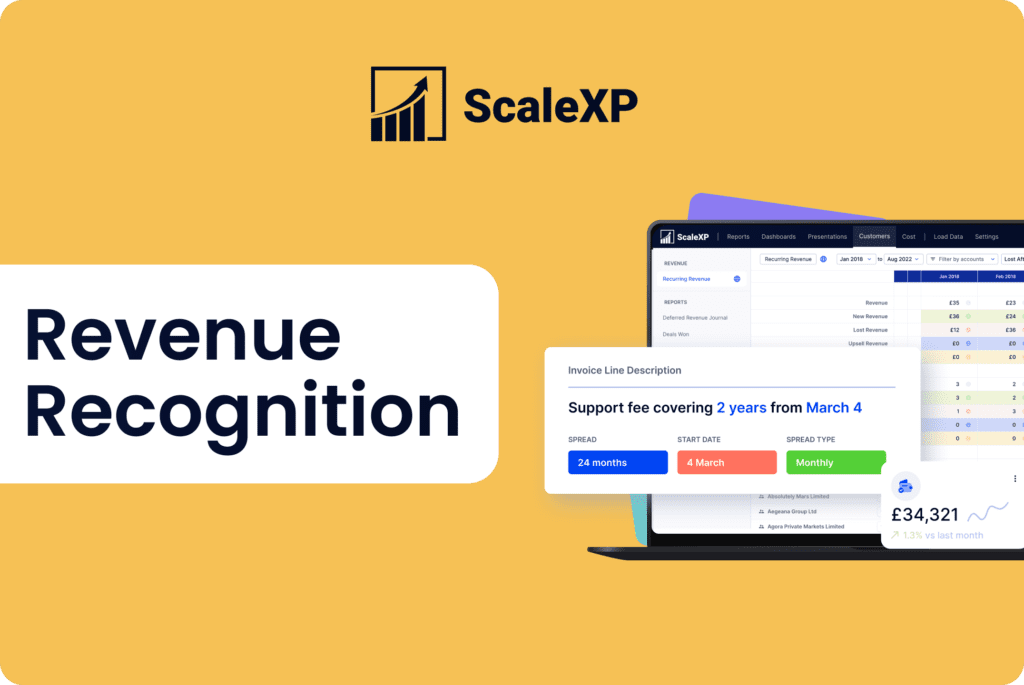What is SaaS revenue recognition?
SaaS (software-as-a-service) is a subscription-based business model in which a company provides access to software platforms over the internet and mobile apps. Revenue recognition for SaaS companies typically involves recognising revenue on a recurring, subscription basis, over the term of the subscription – usually on a monthly or annually recurring schedule. This means that a SaaS company would recognise a portion of the revenue each month.
What is SaaS revenue recognition software?
SaaS revenue recognition software ensures that revenue is recognised correctly and according to accounting standards. The most sophisticated programmes will use smart automations, such as text recognition, to capture the data directly from invoices. Other programmes can require that all contractual terms are entered manually, which creates a longer setup process.
Revenue recognition software also includes the ability to track all critical SaaS metrics including annual recurring revenue (ARR), monthly recurring revenue (MRR), customer acquisition costs (CAC) and lifetime value (LTV).
Learn more about ScaleXP’s SaaS metrics automation here, or check out our latest SaaS benchmarks here.
What are the standards that SaaS companies need to comply with?
Depending on where you’re located, and where you conduct business in the world, your SaaS company will likely need to comply with either the ASC 606, or the IFRS 15. Both of these accounting standards aim to ensure consistency for how entities across various industries approach accounting for similar financial transactions. However, there are a few key differences relating to scope, disclosure requirements, contract costs, presentation of revenue, and transition methods. These differences are explained in the articles linked to below.
- IFRS 15 is a global accounting standard that explains how to recognise revenue from customer contracts. If you’re preparing financial statements using IFRS, you’ve got to follow IFRS 15. This applies to all public and private companies, not-for-profits, and even government entities. The IFRS 15 outlines a five-step process when it comes to revenue recognition for SaaS companies:
- Spot the contract with the customer.
- Figure out the performance obligations in the contract.
- Work out the transaction price.
- Share the transaction price among the performance obligations.
- Record revenue when, or as they fulfil a performance obligation.
For a full breakdown of what you need to do to comply with IFRS 15, check out our article here.
- ASC 606 is a revenue recognition standard issued by the Financial Accounting Standards Board (FASB) in the United States. All public and private companies in the United States are required to comply with the regulations. Similar to the IFRS 15, when thinking about SaaS revenue recognition, the FASB outlines a five step model:
- Identify the contract with the customer.
- Identify the performance obligations in the contract.
- Determine the transaction price.
- Allocate the transaction price to the performance obligations.
- Recognise revenue when (or as) the entity satisfies a performance obligation.
To learn more and understand how this relates to your business, read our ASC 606 blog article.
Who are the leading SaaS software providers?
The two leading SaaS revenue recognition providers are Maxio and ScaleXP. Maxio requires all transactions to be processed through their platform and takes a percentage of your revenue as their fee. On the other hand, ScaleXP can import data from any payment platform (bank transfer, Stripe, any other provider), and the fee is one fixed monthly cost, making it much less expensive as your company grows. ScaleXP is available on the Xero, Quickbooks, HubSpot and Stripe app stores, and you can book in a demo here to see how we can help you!








